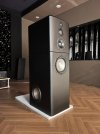I'm building a 4 way active speaker design based on the Genelec W371A, and am hoping to call upon the audio hive-mind to help me figure out how to make the most of the design.
I currently have 2 [mismatched] prototype speakers, and am working on building the final cabinets. The design was originally meant to be roughly the same dimensions as a W371A, but then I decided to add a coaxial driver to the cabinet instead of placing a separate monitor speaker on top. I thought I was making a unique and somewhat larger, full range W371A...but with the recent release of the 8381A, it seems I am now making a smaller and much more affordable 8381A.
The speaker cabinets have 2 front facing drivers and a rear facing subwoofer. I'm using a B&C 12fhx76 coaxial, Lab12 (front facing, sealed), and Dayton RSS256HF-4 (10" rear, ported subwoofer). I'm also using a Peavey VSX 48e signal processor, and an Emotiva XPA amp configured for 8 channels (6 high power modules + 1 stereo module).
So far my philosophy for tuning the system has been based on the theory of using multiple subwoofers to correct for room modes. To me the W371A looks a lot like multiple subwoofers, but all the woofers are in the same cabinet. Crossovers I have been using are 100hz, 120hz, and 1200hz. Left and right are summed below 100hz. And in the measurements below I'm using 48db/octave slope.
Below is a typical result. This is combined left and right channels, measured by REW. I have been using the Time Alignment tool in REW to set delays on the subwoofers, instead of using EQ. I haven't tried every permutation, but initial experiments made me think that using EQ without delays would not be effective with this particular speaker arrangement.
I have applied a small amount of EQ to shape the individual driver's responses when measured at the driver. For example, the horns have an uneven response that needed to be evened out...and still needs a little work! But I have not applied any EQ to "fix" response at the listening position.

I am starting this thread because discussions elsewhere on the forum gave me renewed motivation to expand my understanding of what this driver configuration is capable of. The Genelec is said to be superior to monitors plus multiple subs, and I want to see if my system can do the same.
So how would you approach a project like this? What is the theory to follow, or the "recipe"? REW is the main tool I have, so what measurements in REW would you rely on? Should I do something like using "Spectrograph" and try to keep peak energy time close to 0ms over the whole range? Should I invest in a more powerful measurement tool? I don't really understand how impulse or phase data in REW can be translated into meaningful data.
I can post any data you guys want, but right now I'm not sure what matters or if anybody is interested in playing along.
I currently have 2 [mismatched] prototype speakers, and am working on building the final cabinets. The design was originally meant to be roughly the same dimensions as a W371A, but then I decided to add a coaxial driver to the cabinet instead of placing a separate monitor speaker on top. I thought I was making a unique and somewhat larger, full range W371A...but with the recent release of the 8381A, it seems I am now making a smaller and much more affordable 8381A.
The speaker cabinets have 2 front facing drivers and a rear facing subwoofer. I'm using a B&C 12fhx76 coaxial, Lab12 (front facing, sealed), and Dayton RSS256HF-4 (10" rear, ported subwoofer). I'm also using a Peavey VSX 48e signal processor, and an Emotiva XPA amp configured for 8 channels (6 high power modules + 1 stereo module).
So far my philosophy for tuning the system has been based on the theory of using multiple subwoofers to correct for room modes. To me the W371A looks a lot like multiple subwoofers, but all the woofers are in the same cabinet. Crossovers I have been using are 100hz, 120hz, and 1200hz. Left and right are summed below 100hz. And in the measurements below I'm using 48db/octave slope.
Below is a typical result. This is combined left and right channels, measured by REW. I have been using the Time Alignment tool in REW to set delays on the subwoofers, instead of using EQ. I haven't tried every permutation, but initial experiments made me think that using EQ without delays would not be effective with this particular speaker arrangement.
I have applied a small amount of EQ to shape the individual driver's responses when measured at the driver. For example, the horns have an uneven response that needed to be evened out...and still needs a little work! But I have not applied any EQ to "fix" response at the listening position.
I am starting this thread because discussions elsewhere on the forum gave me renewed motivation to expand my understanding of what this driver configuration is capable of. The Genelec is said to be superior to monitors plus multiple subs, and I want to see if my system can do the same.
So how would you approach a project like this? What is the theory to follow, or the "recipe"? REW is the main tool I have, so what measurements in REW would you rely on? Should I do something like using "Spectrograph" and try to keep peak energy time close to 0ms over the whole range? Should I invest in a more powerful measurement tool? I don't really understand how impulse or phase data in REW can be translated into meaningful data.
I can post any data you guys want, but right now I'm not sure what matters or if anybody is interested in playing along.

